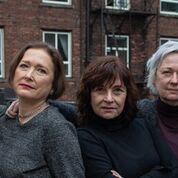Richard III is no prettier a villain today than back then
All the basic condition theatre requires is that fire last night & those costumes
All the basic condition theatre requires is that fire last night & those costumes
& the human voice & people gathered together.
Sir Trevor Nunn, Director (Cats, 1981 \ Les Miserables, 1985)
The women of Shakespeare have often been backlit. Their parts written as if looking out a window into the direct sun. His men, meanwhile, all seem to bask under spots and fresnels in sharp relief.
Not so in Camyar Chai's self-named "allegory" out-take on WS's Richard III. Chai (wrongly) names his piece King Richard and His Women. It should by rights be called The Women of King Richard : because it's they who utterly dominate Chau's scripted re-write of The Bill's original.
One of the bard's early and longest scripts, imagine Richard III distilled down from its original 50+ cast to but five. Also reduced from probably three hours-and-more to just 65 minutes. Sixty-five minutes of hisses & spits shot forth venomously, unremittingly. In cascades.
Never having read or seen Richard III, its battles between the English houses of York and Lancaster in the mid-15th Century were a challenge to follow at times. Two queens, Margaret and Elizabeth (not Good Queen Bess, but another, a century earlier, by marriage). Richard's mom The Duchess. His wife, sort of, Lady Anne.
The connections are all too subtle to explain. But suffice to say Richard was a scheming, conniving, betimes charming -- but mostly cynical -- power-hungry thief. Like certain others in the current realm, dignity, integrity, honesty were far-flung concepts. Which is why Mr. Chai stitched all this together to begin with.
Two quotes sum it up. When attempting to call him out on his various murders, his mother The Duchess and he exchange thus :
D : Oh, let me speak.
R : Do then, but I'll not hear...
D : Thou came'st on earth to make the earth my hell. A grievous burden was thy birth to me : Tetchy and wayward was thy infancy; Thy school-days frightful, desperate, wild, and furious...Thy prime of manhood daring, bold and venturous; Thy age confirm'd, proud, subtle, sly, and bloody, More mild, but yet more harmful-kind in hatred. What comfortable hour canst thou name That ever graced me with thy company?
Death impending, Richard, as if bi-polar, laments :
Richard loves Richard : that is, I am I. Is there a murderer here? No -- yes, I am. Then fly. What, from myself? Great reason why -- Lest I revenge. What, myself upon myself? Alack, I love myself.
King Richard is cleverly-wrought and acted in exemplary fashion by each in their role. Not sure the strip-to-naked killing scene that ends it all -- somewhat mechanically done, as if collecting laundry for the weekly wash -- not sure it was dramatically necessary, but it is what it is.
A woman beside me wept openly at show's end. I know not why but doubt not her pain from whatever source. As always, Seven Tyrants produces a powerful script. To single out indivudul actors for excellence here would be unfair to the others as well as redundant. Except perhaps to remark how consistently Daniel Deorksen carried off Richard's deformity by hoisting his right shoulder, constantly. My rotator cuff strain ached mightily in sympathy and honour.
Suffice to say each and every actor on stage looked utterly drained & exhausted & spent after Saturday's matinee. This is rife stuff for Shakespeare aficionados (and English monarch history buffs). You will have a weary ride home as you contemplate all the misery you have just seen acted out so compellingly by the cast.
Suffice to say each and every actor on stage looked utterly drained & exhausted & spent after Saturday's matinee. This is rife stuff for Shakespeare aficionados (and English monarch history buffs). You will have a weary ride home as you contemplate all the misery you have just seen acted out so compellingly by the cast.
Particulars : Script by Bill Shakespeare, as adapted by Camyar Chai. Produced by Seven Tyrants Theatre. At the Tyrants Studio stage, top floor, The Penthouse Club on Seymour @ Nelson. On until April 19, 2019. Run-time 65 minutes, no intermission. Tickets & schedule information @ Tyrants.
Production team : Director Camyar Chai. Lighting Designer David Thomas Newham. Sound & Music Designer Daniel Deorksen. Stage Manager Victoria Snashall. Publicist Marnie Wilson. Front of House Manager Cobra Ramone.
Performers : Leanna Brodie is “Elizabeth”, Ghislaine Dote is “Anne”, Sandra Ferens is “The Duchess” and Linda Quibell is “Margaret”. 7-Tyrants co-founder Daniel Deorksen is “King Richard”.
-30-







